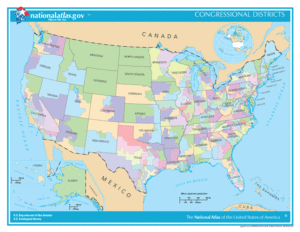Congressional district
A congressional district is an electoral constituency that elects a single member of a congress. Countries with congressional districts include the United States, the Philippines, and Japan. A congressional district is based on population, which, in the United States, is taken using a census every ten years.
Japan
Philippines
United States

There are 435 congressional districts in the United States House of Representatives,[1] with each one representing approximately 711,000 people.[2] In addition to the 435 congressional districts, the five inhabited U.S. territories and the federal district of Washington, D.C. each send a non-voting delegate to the House of Representatives. The Census Bureau within the United States Department of Commerce conducts a decennial census whose figures are used to determine the number of congressional districts within each state. The 2012 elections were the first to be based on the congressional districts which were defined based on the 2010 Census data.[3]
See also
- List of electoral districts by nation
- House of Representatives (Japan)
- House of Representatives of the Philippines
- United States House of Representatives
References
- ↑ See Public Law 62-5 of 1911, though Congress has the authority to change that number. The Reapportionment Act of 1929 capped the size of the House at 435.
- ↑ Congressional Apportionment. 2010 Census Briefs U.S. Census.
- ↑ "GreatData.com". Retrieved 12 June 2013.